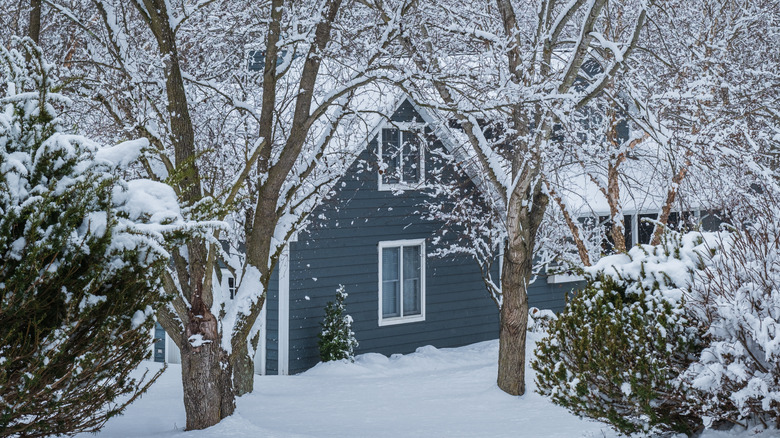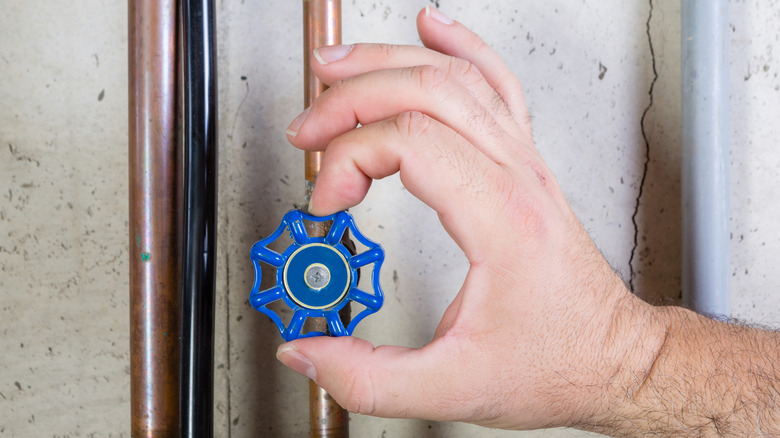How To Safely Winterize An Empty House If You Spend Winter Away From Home
Leaving your house empty for the winter is a wonderful feeling when you're escaping to a warmer location, but returning home to a burst water pipe and a flooded basement is a nightmare no one wants to go through. A property left vacant during the coldest months is vulnerable to both weather-related issues and break-ins. Just locking the doors isn't enough to protect your home, so understanding how to prep your home for cold weather is important. You need to take proactive steps to safeguard it from freezing temperatures and unexpected issues, since even minor problems — like a poorly sealed window or a pipe freezing in an unheated cabinet — can lead to thousands of dollars in repairs.
Setting your property up for a long absence means creating a climate-controlled interior that keeps your home at a safe temperature and an exterior that fools potential intruders into believing the house is still occupied. Before packing, take time to protect your home and belongings from the risks of leaving it empty.
The most important things to do to protect your vacant home from freezing pipes and water damage
The most significant danger to an unoccupied home in cold weather is water damage from burst pipes, which can happen if the heat fails or temperatures drop too low inside the walls. The best preventive step is shutting off the main water supply, which stops continuous flow if a pipe bursts. After turning off the water, you should drain the plumbing in the house by opening the highest faucets in the house first. Then work your way down to the lowest ones, like those found in a basement bathroom or laundry room, to allow air into the system.
Shutting down the water heater and draining it is another step in winterizing your home for when you're away. Pour non-toxic, biodegradable antifreeze into all sink P-traps and toilet bowls to prevent any remaining water from freezing and cracking the porcelain or pipes. For heating and electricity, there are important tips to help you save energy this winter while protecting your home. Experts recommend setting your thermostat to at least 55 degrees Fahrenheit. This helps keep the inner walls warm enough to stop water lines from freezing, even if the exterior walls get very cold.
Finally, unplug appliances like the microwave, coffee maker, and television to save energy and reduce the risk of electrical issues while you're gone. It's also recommended to check for and seal any drafts around doors and windows using weather stripping or caulk. This prevents heat loss and stops cold air from getting inside and reaching water lines in exterior walls.
Deterring intruders and securing the exterior before you leave for the winter season
Securing a vacant house is largely about making it look lived-in and inaccessible. To winterize sliding glass doors and other entrances, you need to use quality deadbolts, security hinges, and slide locks for any sliding door. In terms of appearance, a messy and unkempt yard can signal that no one is living there. Arrange for someone to clear snow and ice after storms to keep walkways safe and maintain the appearance that someone is home and taking care of the property. You should also stop mail and newspaper delivery or ask a friend or trusted neighbor to collect them, so the mail doesn't pile up.
To automate the illusion that you're still home, set your interior lights on timers and set them to come on at different times to discourage anyone from breaking in. Motion-sensitive exterior lights are another deterrent to keep people away from your home. With a little preparation before you leave, you can enjoy your winter away knowing your home is protected, secure, and ready to greet you in the spring.


